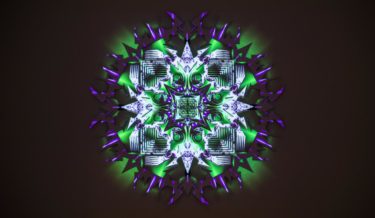Although the film Interstellar came pretty close to accurately depicting the (theoretical) appearance, of a black hole, since light cannot escape them, they’re notoriously hard to illustrate. In the new audiovisual project Dark Hearts of Space, however, musician and visual artist Dasha Rush, in collaboration with Stanislov Glazov, explores the voids of black holes, doing so through real-time with generative visuals.
Rush developed Dark Hearts of Space at the Banff Centre Canada, where she was an artist-in-residence. Premiering at Mutek Festival in Montreal this past year, the performance combined Rush’s experimental sound design and music with Glazov’s visualization of a black hole, made with TouchDesigner (the same software used to create Amon Tobin’s groundbreaking ISAM visuals).

“The subject of the black holes is generally very appealing to me,” Rush tells The Creators Project. “I guess the mystery of cosmos, unknown, something reachable only (mostly) in a theoretical or artistic way.”
“As an artist, in the specific context of this particular creative process, it all started from the point where I wanted to work with silence in musical composition in general,” she adds. “Technically, it’s more common in modern classical music than electronic music, especially techno.”
Rush wanted to create “gaps” inside a rich musical environment—moments in the listening experience where time and space became suspended though listeners would remain inside the musical composition. So for Dark Hearts of Space it became obvious these these gaps of musical silence would be about a void of some sort.

“I would imagine how the void (nothing or silence) would sound,” Rush says. “So, silence, nothing—where is that place, where do I hear the void? Then progressively came a thought: how would I visualize void or “nothing”… [this thought] process brought me to black holes.”
Sonically, Rush decided to have improvisation (on Native Instruments’ Reaktor) be an important aspect of the Mutek performance. Rush and Glazov decided the visuals would be real-time and generative, reacting to Rush’s sounds as each sequence unfolded.
“For Dark Hearts of Space, the main challenge was to deal with volumetric gaseous structures,” Glazov explains. “In order to [create] this effect we did a lot of GLSL programming using raymarching technology (volume rendering) and particle simulations.”

Glazov says that this technology allowed them to create a black hole that had “presence.” Judging by the new video, it certainly appears to be so. Of course, the performance also requires multiple screens, rear projectors, and smoke to pull off the 360-degree holographic look of the black hole hanging in the void of the stage’s space.
“It is a dramatized, theatrical journey to the center of a black hole, [so] I would like to invite the listener and viewer to experience the singularity,” Rush says. “Obviously not in a literal, physical sense, which would be impossible here anyway, but more in the artistic and poetic sense […] with a certain playful aspect of the depths of light and the physicality of the sound pressure, with which we are trying to interpret the void.”
The European premiere of Dasha Rush and Stanislav Glazov’s Dark Hearts of Space is set for October 16th at Unsound. Eventually, Rush hopes to turn the performance into a permanent installation.
Dark Hearts of Space from Licht.Pfad Studio on Vimeo.
Click here to see and hear more of Dasha Rush’s work, and here to check out Stanislav Glazov’s video work.
Source Creators
Follow our FB page Lumen




